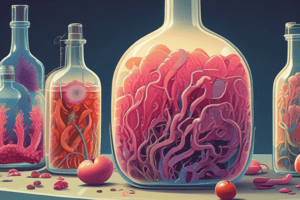Podcast
Questions and Answers
What is the primary source of biological carbon dioxide production?
What is the primary source of biological carbon dioxide production?
- Yeast fermentation (correct)
- Bacterial fermentation
- Plant photosynthesis
- Animal respiration
How many yeast cells are approximately in one pound of compressed yeast?
How many yeast cells are approximately in one pound of compressed yeast?
- 30 trillion
- 20 trillion
- 10 trillion
- 15 trillion (correct)
What is the purpose of fermentation in yeast cells?
What is the purpose of fermentation in yeast cells?
- To reproduce by budding
- To break down sugars for energy (correct)
- To synthesize starch
- To produce alcohol
Who proved that living yeast was necessary for fermentation?
Who proved that living yeast was necessary for fermentation?
What is the function of amylase in bread baking?
What is the function of amylase in bread baking?
What is the term used to refer to the many enzymes in yeast that break down sugars?
What is the term used to refer to the many enzymes in yeast that break down sugars?
What is the overall process by which yeast breaks down sugars to carbon dioxide?
What is the overall process by which yeast breaks down sugars to carbon dioxide?
What is the proportion of alcohol produced during fermentation compared to carbon dioxide?
What is the proportion of alcohol produced during fermentation compared to carbon dioxide?
What is the result of yeast fermentation in yeast-raised baked goods?
What is the result of yeast fermentation in yeast-raised baked goods?
What happens to yeast fermentation when the dough temperature rises above 120°F (50°C)?
What happens to yeast fermentation when the dough temperature rises above 120°F (50°C)?
What is the effect of salt on yeast fermentation?
What is the effect of salt on yeast fermentation?
What happens to yeast fermentation when a large amount of sugar is added?
What happens to yeast fermentation when a large amount of sugar is added?
What is the ideal pH range for yeast fermentation?
What is the ideal pH range for yeast fermentation?
What is the effect of antimicrobial agents on yeast fermentation?
What is the effect of antimicrobial agents on yeast fermentation?
What happens when a large amount of yeast is used in a lean dough?
What happens when a large amount of yeast is used in a lean dough?
What type of sugar is fermented slowly?
What type of sugar is fermented slowly?
Why is it best to use a small amount of yeast when using a long fermentation time?
Why is it best to use a small amount of yeast when using a long fermentation time?
What is the purpose of using a preferment in yeast doughs?
What is the purpose of using a preferment in yeast doughs?
Why is active dry yeast not popular with professional bakers?
Why is active dry yeast not popular with professional bakers?
What is the ideal temperature for hydrating active dry yeast?
What is the ideal temperature for hydrating active dry yeast?
How much active dry yeast should be used compared to fresh compressed yeast?
How much active dry yeast should be used compared to fresh compressed yeast?
What is the main advantage of using active dry yeast in pizza or tortilla production?
What is the main advantage of using active dry yeast in pizza or tortilla production?
When was instant yeast developed?
When was instant yeast developed?
How should instant yeast be added to dough?
How should instant yeast be added to dough?
How much instant yeast should be used compared to fresh compressed yeast?
How much instant yeast should be used compared to fresh compressed yeast?
How long can unopened instant yeast last at room temperature?
How long can unopened instant yeast last at room temperature?
What type of yeast strains grow well in high-sugar environments?
What type of yeast strains grow well in high-sugar environments?
What happens when regular yeast is used in sweet, rich doughs?
What happens when regular yeast is used in sweet, rich doughs?
What is the name of the traditional, naturally fermented sourdough starter in French?
What is the name of the traditional, naturally fermented sourdough starter in French?
How is a sourdough starter typically prepared?
How is a sourdough starter typically prepared?
What is the main advantage of using pure yeast cultures?
What is the main advantage of using pure yeast cultures?
What is the typical color of fresh compressed yeast?
What is the typical color of fresh compressed yeast?
How is compressed yeast typically used?
How is compressed yeast typically used?
What is the main characteristic of active dry yeast?
What is the main characteristic of active dry yeast?
What is the treatment that active dry yeast undergoes to reduce moisture?
What is the treatment that active dry yeast undergoes to reduce moisture?
What is the approximate proportion of dead yeast cells in active dry yeast?
What is the approximate proportion of dead yeast cells in active dry yeast?
Flashcards are hidden until you start studying
Study Notes
Yeast Fermentation
- Yeast fermentation is a process in which yeast cells break down sugars for energy, producing carbon dioxide and alcohol as byproducts.
- Yeast uses the energy for survival and reproduction.
- The rate of yeast fermentation is affected by several factors, including temperature, amount of salt, amount of sugar, type of sugar, pH of dough, presence of antimicrobial agents, and amount of yeast.
Yeast Cells
- Yeast cells are very small, single-celled microorganisms, with approximately 15 trillion cells in one pound of compressed yeast.
- Yeast cells reproduce by budding, and visible scars from previous buddings can be seen on the yeast cell.
Enzymes and Fermentation
- Yeast can be thought of as tiny enzyme machines, breaking sugars into smaller and simpler molecules with every step.
- Yeast lacks amylase and cannot break down starch into sugar, which is why amylase is an important additive in bread baking.
- The overall process of fermentation involves multiple steps, controlled by separate enzymes, and produces carbon dioxide, alcohol, and small amounts of flavor molecules.
Factors Affecting Yeast Fermentation
- Temperature: Yeast is dormant at 32–34°F (0–1°C), active at 50°F (10°C), and slows down at 120°F (50°C), with an optimal temperature of 78–82°F (25–28°C).
- Amount of salt: Salt retards yeast fermentation, and the optimal amount of salt is 1.8–2.5% (baker's percentage).
- Amount of sugar: Small amounts of sugar (up to 5%) increase yeast activity, while large amounts (above 10%) slow fermentation.
- Type of sugar: Sucrose, glucose, and fructose are fermented rapidly, maltose is fermented slowly, and lactose is not fermented at all.
- pH of dough: The optimal pH for yeast fermentation is an acidic 4 to 6.
- Presence of antimicrobial agents: Certain antimicrobial agents slow or stop yeast fermentation.
- Amount of yeast: The more yeast, the faster the fermentation, but excessive yeast can add an undesirable yeasty flavor and exhaust dough of sugars.
Types of Yeast
- Compressed yeast: Fresh, moist cakes or blocks with 30% yeast and 70% moisture, lasts up to two weeks when stored wrapped in plastic and refrigerated, and three to four months when frozen.
- Active dry yeast: Dried granules with less than 10% moisture, sold in vacuum-packed jars or pouches, and lasts several months at room temperature, longer if frozen or refrigerated.
- Instant yeast: Developed in the 1970s, instant yeast can be added directly to dough without first hydrating in water, and is more vigorous than compressed or active dry yeast.
Sourdough Starters
- Sourdough starters are prepared by mixing flour and water, allowing wild yeast and lactobacilli bacteria to ferment, and can be used to leaven bread.
- Fresh starter does not need to be made for each new day's production, and can be saved for the next day's bread by mixing it with fresh flour and water.
- Some bakeshops pride themselves on the number of years they have continued to bake from their original starter.
Studying That Suits You
Use AI to generate personalized quizzes and flashcards to suit your learning preferences.




